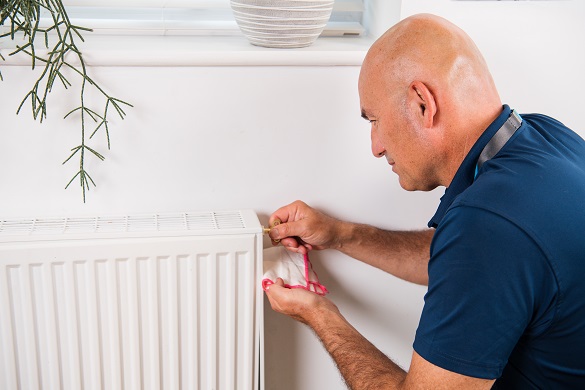Leaks happen from time to time. Fortunately, they're often easy to fix, although it helps if you get to the bottom of the problem early. Left untreated, they can cause major damage to your floor and radiator, which are expensive to replace. Plus, if the leaking radiator is upstairs, there’s also the chance of water trickling through the ceiling. But don’t worry – we’re here to help you find (and fix!) all kinds of leaks.
Why is my radiator leaking?

Here are some issues that might be causing your radiator to leak:
- Damage to parts of the radiator (Includes the spindle, pipe joints and valves.)
- Loose parts
- Manufacturing faults
- Cracks or holes caused by ‘sludge’ (A build-up of dirt, sediment and rust inside the radiator.)
If well cared for, your radiators can last for many years. Eventually, though, they’ll wear out and require replacing. If you notice when your heating’s on that they’re colder than usual, it could be time to organise a replacement. Just make sure to consider these fixes first. Something as simple as bleeding your radiators could be all it takes to get them piping hot again.
Signs your radiator might be leaking

Dry your radiator with a towel so it’s easier to see if there’s a leak (fingers crossed, any water will be from condensation). Then keep an eye out for…
- Puddles
- Water dripping down the radiator
- Dirty marks on the radiator and brown water droplets (Signs of rust and corrosion.)
- Low boiler pressure
How to fix a leaking radiator
If you’ve spotted something but aren’t a confident DIYer, leave the leak to a plumber. If you’re comfortable fixing it yourself, try these tips.
1. Switch the heating off and let the radiator cool down

To avoid any nasty burns, turn your heating off and wait until it’s cold. Make sure the radiator is dry too
2. Find the source of the leak
If you think the problem is with the radiator itself, the towel drying technique should help. When it’s dry, check for water dripping down the front – then retrace the droplets to find where the leak starts.
This type of leak is sometimes caused by ‘sludge’ corroding the inside of the radiator. However, surface cracks can also be a result of a manufacturing defect. There are special sealants you can buy from hardware stores, but these are only for patching minor cracks. It’s best to check the manufacturer’s guidelines for advice on what sealant to use. And depending on the level of damage, you might need to replace the radiator.
If you think the valve joints are at fault, wipe some tissue around them and see if it gets wet. This will help you find the leak’s exact location.
3. How to fix a leaking radiator valve

Tighten the nut where the leak is coming from with a spanner, removing the valve cover if necessary. Depending on the style of your radiator, you might have to remove the cover with a screwdriver to access the gland nut.
If this doesn’t work, you’ll need to repair the valve. If you’re confident doing so yourself, gather the following items…
- Towels
- Spanner
- Screwdriver
- Radiator key (or bleed key)
- Bucket or bowl
Then follow these steps:
- Turn off your water supply and lockshield valve
- Lay towels under the radiator and the supply pipe to catch any drips
- Undo the union nut, using a spanner
- Open the bleed valve with a screwdriver (You can use a bleed key too.)
- Drain the radiator (Use a bucket to catch the water.)
- Wrap the ridged end of the valve (also known as the valve tail) in plumbers, ‘PTFE’, tape to patch the leak
- Close the bleed valve and re-tighten the nut
4. Turn your heating back on and check for leaks
Turn on your water supply and heating. And don’t forget to open the lockshield valve. Wait for the radiator and heating system to fill up with water again so you can confirm the leak has gone.
What to do if this doesn’t fix the issue
If it’s still leaking, it could mean you need to replace parts of your radiator. If you regularly take on trickier DIY jobs, you might be able to do this yourself. But if you’re not comfortable, or sure what exactly is causing the leak, it’s best to book a repair with a plumber.
Our blog is loaded with more related articles

Plumbing and heating tips
Heating not coming on? There could be a simple fix...
It’s that time of year again, one of the busiest for heating engineers, when people start to turn their heating on after...
Read more

Plumbing and heating tips
How to bleed a radiator
If your radiators aren’t heating up properly, they may need bleeding. Read our guide on how to bleed a radiator, and find...
Read more

Plumbing and heating tips
How to prevent and fix frozen water pipes
Unfortunately, the drop in temperature means you might have another thing to add to your to-do list: sorting out frozen water p...
Read more
